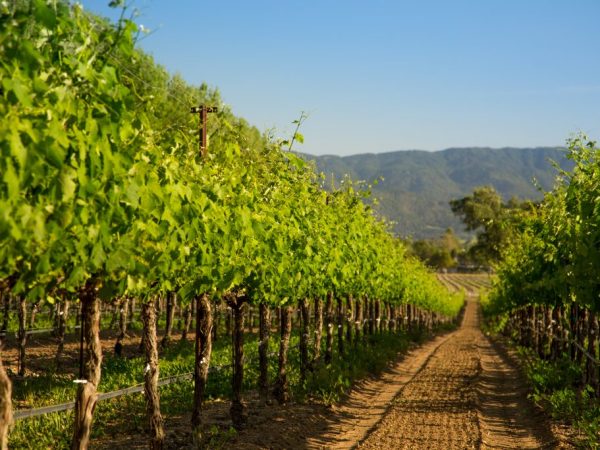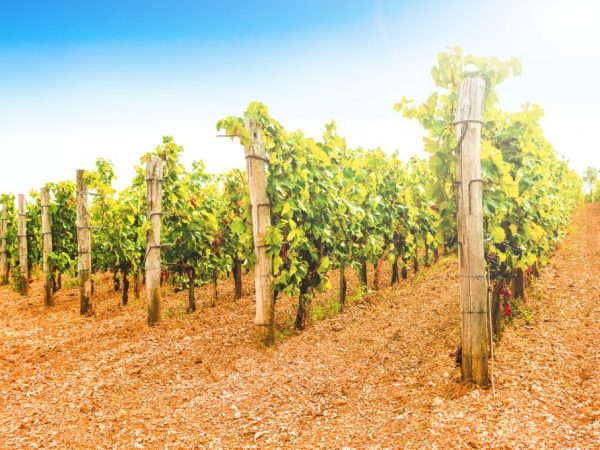How to care for grapes in spring
Grapes in the spring require feeding and skillful pruning. The reward for the diligent gardener will be a strong vine with large clusters of sweet berries. Caring for grapes in spring consists of a mandatory set of actions, which must be started after winter, as soon as the snow melts and the topsoil dries slightly.

Spring grape care
Shelter removal
It is permissible to fully open the vine only if the possibility of frost is excluded.
In the south, spring grape care and shelter removal is carried out as soon as the average daily temperature reaches 5 ° C-7 ° C. If you do not do this in time, quickly germinating buds and shoots will be damaged.
In regions with a harsher climate and the usual frosts in the spring, the vine is opened gradually:
- form ventilation holes;
- check the degree of development of the kidneys to the stage of the green cone;
- open the vineyard in several stages.
Many gardeners in central Russia determine the time to remove protection and how to care for overwintered grapes in spring, according to the state of the bush. Germinating shoots, not swollen buds, are considered a landmark.
When the vine is open, be sure to wake it up:
- loosen the soil around;
- water the soil well with warm water;
- mulch (black agrofibre is suitable for this).
Watering the grapes in the spring is necessary to help the root system earn quickly and fully, providing the plant with everything it needs.
Work on the opening of grapes in spring is carried out in cloudy weather: the bright rays of the sun harm the plant.
Assessment of the condition of the vine
Abrupt climate change creates many problems for the growers. Among them:
- sharp alternations of plus and minus temperatures: they affect the height of the snow cover, which leads to freezing of the vine and death of the eyes;
- an unexpected abnormal decrease in temperatures: it leads to the freezing of a large number of future buds and a sharp decrease in yield;
- sudden spring frosts with steady warming.
To properly care for grapes in the spring, be sure to wisely approach the formation of the vineyard.
Tips from experienced winegrowers to young:
- choose a zoned variety for planting, adapted to climatic conditions;
- vaccinate on a frost-resistant stock;
- immediately form the plant correctly, leaving a reasonable number of eyes;
- reliably cover the plant for the winter;
- water the grapes in the spring, tie, cathartic and feed the bushes, observing the rules;
- do not be greedy in anticipation of a large harvest, but it is reasonable to load the shoots with bunches.
If the opening of the bushes in the spring has shown a successful wintering, they begin pruning and tying young bushes.
If the vines wintered without complications, the excess number of shoots is normalized by pruning. It is completed before bud break.This contributes to an increase in the amount of nutrients supplied to the berries, facilitates the care of grapes in spring and summer, and forms and rejuvenates the plant.
Stepping

Excessive shoots must be removed
To form a beautiful transparent grape bush, capable of producing large sweet berries, pinching is performed, that is, unnecessarily overgrown shoots of the second order are removed. They make the bush thicker, taking nutrients from fruiting shoots and berries.
Patching is performed one month after the main pruning. Pinching of shoots is carried out at the level of the second sheet, the same procedure is performed with stepchildren of the second order. Too overgrown break out. Pinching and breaking off young shoots allows you to direct the forces of the plant to the formation of berries.
Pruning and shaping the bush
The formation of a bush after wintering depends on its condition and the degree of freezing. After opening, the grapes are carefully examined in the spring, the pruning scheme is determined:
- if more than ¾ shoots have been subjected to freezing, the frozen and old ones are cut out;
- if a smaller amount of vegetative mass is damaged, unnecessary parts are removed, leaving 5-15 eyes on each left shoot;
- if complete freezing of the buds on the living tissues of the bush is noted, all shoots are cut off, leaving several buds;
- with complete freezing of the aboveground part, it is cut out all, the vine is restored with the help of grafting.
Spring crop care involves pruning only damaged and young bushes up to two or three years of age.
The fruiting vine is pruned in the fall. The procedure is carried out in the following order:
- cut out non-viable parts;
- carry out the formation of the bush;
- carry out the garter of the vine.
To reduce damage to the vines, a sharpened pruner is used to cut thin shoots. The springs of the device are lubricated with oil. The cut is formed as small and smooth as possible: this prevents stagnation of water, the appearance of rot and fungal diseases.
It is customary to whitewash the trunk of some garden trees. There are several reasons for doing this for grapes:
- a layer of lime protects the tender bark of seedlings from the bright sun;
- the whitewashed plant "wakes up" later, surviving dangerous frosts in spring more successfully;
- modern whitewash compounds protect plants from pests.
Plants are processed in dry weather, the air temperature should be above 0 ° C.
Stopping juice production (crying vine)
Pruning the vine during the period when it wakes up causes a specific phenomenon with the beautiful name "crying". This is an intense release of moisture from cuts or fractures. The process lasts about a month and stops on its own.
The "cry of the vine" signals that the roots of the plant are in good health. Too active outflow of juice during development can lead to a significant weakening or drying out of the crop due to the loss of moisture and nutrients.
To stop the loss of juice and save the crop, they use:
- coating the wounds with a mixture of red lead, boric acid and chalk, a special ready-made balm for sections;
- burning the upper edge of a thin vine, which causes the sap to roll up and stop the release of moisture;
- pulling the vine with a wire to stop sap flow.
Growers who use the method of early watering, loosening and mulching the soil around the vine are less likely to face the problem of juice production. This is something for beginners to take note of.
Pest control

Treat plants from pests in time
The vineyard in the spring needs to be treated against pests. Fighting them is an indispensable part of the complex of work on the care of the vine. This allows you to significantly increase the yield and reduce the incidence of bushes. Prevention is easier than treating later. It includes the following steps:
- processing in the period after removing the shelter before budding with a solution of copper sulfate;
- after the appearance of several leaves, in the first week of May, - with a special complex preparation "Horus" against pests and diseases;
- prophylaxis with the drug against ticks and pests "Sunmight" in the first week of May;
- processing a week before flowering of the main array of vines of the plant with a mixture of insecticides ("Ridomil", "Topaz", "Decis");
- processing at the stage of mass flowering of grapes with similar preparations.
The preparations are diluted and processed according to the instructions on the package in the morning.
Watering and feeding
Adequate moisture and nutrients in early spring ensure the vines are vigorous and productive. Experienced gardeners recommend watering dormant grapes in the spring immediately after removing the shelter. Some growers feed and spray the vine at the beginning of summer (after the soil dries out and the bushes begin to bloom). The best solution is to install drip irrigation.
The vine is fed at the root and sprayed several times during the period. An approximate scheme of spring root top dressing looks like this (provided that fertilizers were not applied in the fall):
- in early spring, immediately after removing the "fur coat", the soil is loosened, moistened, sprinkled with wood ash, mulched;
- a few days later, during the green cone period, they are treated with a mixture of superphosphate fertilizers and urea (30 g per bush);
- a few days before flowering, watering and feeding with an aqueous solution prepared from 1 tbsp. l. saltpeter, 2 tbsp. l. superphosphate and 1 g of potash fertilizers (per bush); breeding is carried out in a bucket of water.
Use the following root feeding scheme:
- mix 5 tbsp. l. saltpeter, 4 tbsp. l. magnesium and superphosphate, 3 tsp. potash fertilizers;
- dissolve the mixture in water for irrigation;
- punctures are made in the soil with a metal pin to the depth of the roots;
- water with a solution of fertilizers is poured under the root of the vine.
When using a solution of organic fertilizers, the rate of nitrate is reduced by 50%.
If necessary, spray the bushes before flowering with a solution of ready-made fertilizers. The procedure is performed on cloudy days in the morning or before sunset.
Restoration of plantings

Periodically it is necessary to change old bushes to young ones.
Activities in the vineyard in spring are not limited to just caring for existing plants. At the same time, new bushes are planted and redundant, damaged or incapable of fruiting are removed. All this helps to grow a good harvest.
The most common way to propagate grapes is by cuttings, which allows you to get a high-quality seedling of the desired variety. It is possible to restore the planting of decorative girlish grapes not only by cuttings, but also by seeds.
The preparation of cuttings (shanks) harvested from the fall is carried out in late winter and early March). The planting material must be of high quality. To cut grapes without problems, a number of rules are followed:
- branches are cut from a high-quality fruitful vine with brown bark (from the middle part, crackling when bent);
- the cut stalk must have at least 4 buds and be up to 5 mm in diameter;
- fattening vines (thick, over 5 mm) are not used for seedlings.
Before storing, the planting material is marked, then placed in a dark, cold place: a cellar, a trench, a refrigerator. The storage temperature should not exceed 5 ° C: the cuttings should not dry out.
At the end of winter, seedlings must be germinated in water, soil or a damp peat tablet. Roots appear in the third week.
Rooting cuttings in March at home allows you to plant young grapes in late April-mid-May. The timing of planting should exclude the possibility of the return of frosts, destructive to the vine.
Before boarding, it is important:
- inspect each seedling, check the root system and the integrity of the bark;
- 2-3 days before planting, treat the plants with a growth stimulator;
- dig a sufficiently voluminous hole for planting: 15-20 cm more than the roots of the cutting;
- pour organic fertilizer, humus, mixed with earth on the bottom with a slide.
To plant and root a seedling, adhere to the following sequence of actions:
- plant a seedling, directing the roots down;
- cover with earth, tamp thoroughly, tie to a peg;
- pour a bucket of water into the resulting trunk circle;
- mulch the trunk circle with black film.
Subsequently, young vines are provided with thorough watering and feeding.
Conclusion
The complex of agrotechnical spring works on pruning, tying and feeding grapes makes it possible to form strong vines that can survive the winter without loss. If the cuttings are germinated in time, the young bushes are trimmed, and the tinting is carried out, in the future you will not have to treat the culture and take care of its yield.


